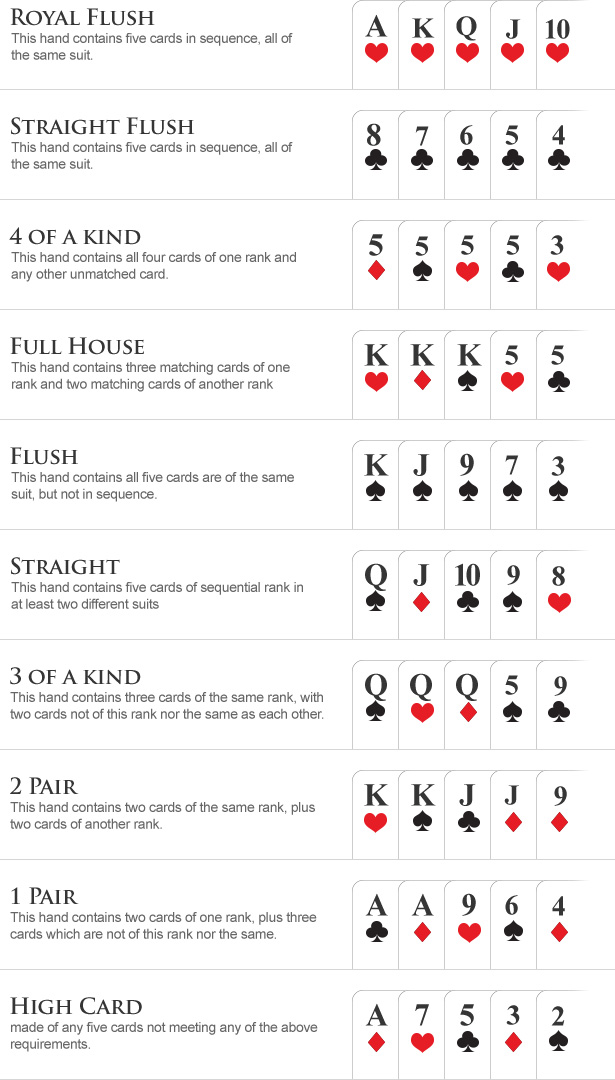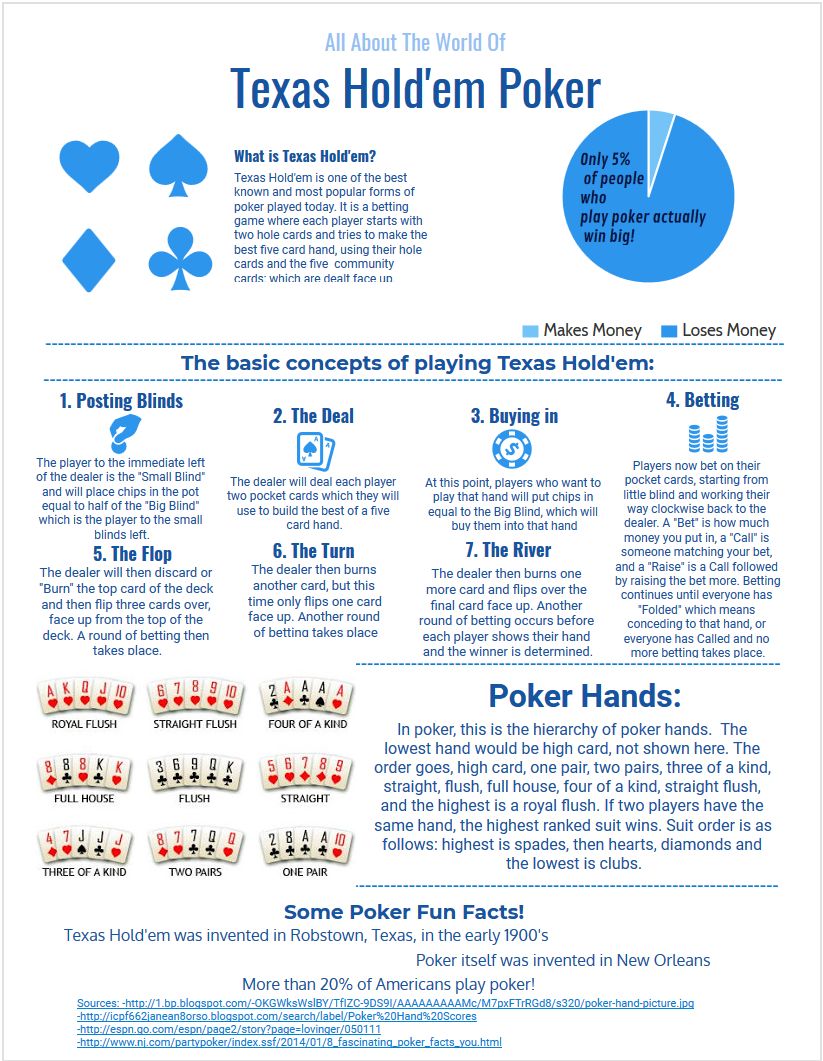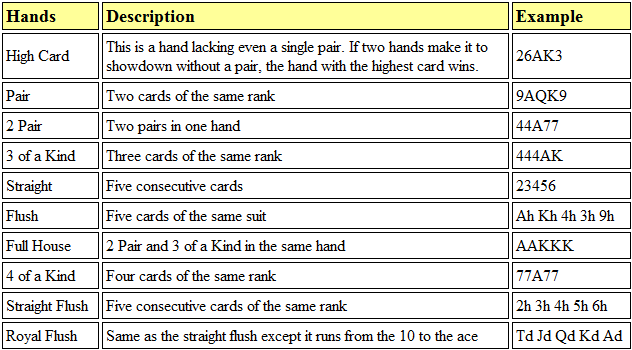Poker Hold Em Rules
The two players to the left of the dealer must post these compulsory “blinds” – so called because they are placed before anyone even sees their cards. The player on the dealer’s immediate left posts the “small blind” and the player one further seat round the table posts the “big blind”, which is usually twice the size of the small.
These hand rankings aren't specifically part of Texas hold'em rules, but apply to many different poker games. Royal Flush — five cards of the same suit, ranked ace through ten; e.g., A ♥ K.
- Texas Hold’em Rules – The Basics Texas Hold’em is a community card game, meaning that the result depends on five community cards shown face-up on the table in combination with two cards each of the players is holding in their hands. Texas Hold’em poker can feature a minimum of two and a maximum of ten players at one table.
- Texas Hold’em Rules. In Texas hold’em each player is dealt two cards called their ‘hole’ cards. Hole cards can only be seen and used by one person. The dealer button (denoted by a circular disc) is allocated before hands are dealt to allow for the positioning of the forced bets: small blind and big blind, and also to determine who will act first and last in the hand.
- Texas hold 'em (also known as hold'em or holdem) is another version of the standard card game of poker. A dealer shuffles the cards then deals 2 cards to each player and then five community cards are placed by the dealer—a series of three ('the flop') then two additional single cards ('the turn' and 'the river').
In the illustration, the dealer is in seat five with the button in front of him. The two seats to his left are “in the blinds”.
After every hand is complete, the dealer button moves clockwise one position around the table, which means that players take turns to be the dealer, the small blind and the big blind.
After the blinds have been posted, all players are dealt two cards face down. These are known as “hole” cards, and can only be seen and used by one player. By the end of the hand, five more “community” cards may have been dealt, face up in the middle of the table, which are available for all players to use.
The first three of the community cards are exposed together (known as the “flop”), then a fourth card (known as the “turn”) is dealt individually, and then a fifth (known as the “river”) is exposed. A betting round separates each deal.
The aim of poker is to make the best five-card hand out of the seven available – two in an individual’s hand and the five community cards.
The Four Betting Rounds
If a hand of poker is played all the way to its conclusion, there will be four betting rounds – or four periods during which players can commit their chips to the pot. A player can also “fold” their cards and leave the action at any time (see below).
A betting round must be concluded satisfactorily before the remaining players see more cards and another betting round begins.
Pre-Flop – The First Round of Betting
The first betting round takes place before the first three community cards (the “flop”) are dealt. This action is described as “pre-flop” and at this stage players are wagering based solely on the strength of their two concealed “hole” cards.
The player sitting to the left of the big blind acts first – a position known as “under the gun”. Players then act in turn, moving clockwise around the table.
You have the following options when it is your turn to act:
- Fold: This means that you no longer want to play the hand, and are throwing your cards away. You no longer have any claim to the money in the pot, even if you paid one of the blinds.
- Call: This means that you want to play the hand by matching the size of the current bet. Pre-flop, this will be at least the size of the big blind, and may be greater if any other player has raised.
- Raise: This means that you want to raise the size of the current bet. If nobody before you has made a raise, you can make a raise yourself.
- If you are sitting in the big blind and no else has raised before you, you have the option to check. This means that you do not wish to commit any more chips to the pot. You can only check pre-flop if you are in the big blind and no one else raised.
Driven by the popularity of televised poker, Texas Hold'em (more commonly, ‘Hold'em’) has become the world’s most popular poker game, both in live casinos and online at PokerStars. We’ll go into more detail below, but here are the key points you need to know:
- Every player is dealt two cards, for their eyes only
- The dealer spreads five cards - three at once, then another, then another - which can be used by all players to make their best possible five-card hand
- Before and after each card(s) is revealed, players take turns to bet. To stay in the hand and see the next card, all players must have put the same amount of chips in the pot as each other
- The best poker hand wins the pot

It’s a simple game to learn, yet has the potential to be played with a seemingly infinite variety of strategies, tactics and nuance.
The Rules of Texas Hold’em
Before you begin playing Hold'em, you'll want to learn the rules. In Hold'em, each player is dealt two private cards (known as ‘hole cards’) that belong to them alone. Five community cards are dealt face-up, to form the ‘board’. All players in the game use these shared community cards in conjunction with their own hole cards to each make their best possible five-card poker hand. In Hold'em, a player may use any combination of the seven cards available to make the best possible five-card poker hand, using zero, one or two of their private hole cards. To view the rankings of poker hands, visit the poker hand ranks page.

The four major variations of Hold'em are distinguished from each other by their betting limits:
- Limit Texas Hold'em: There is a pre-determined betting limit on each round of betting.
- No Limit Texas Hold'em: A player can bet any amount, up to all of their chips.
- Pot Limit Texas Hold'em: A player can bet any amount, up to the size of the pot.
- Mixed Texas Hold'em: The game switches between rounds of Limit Texas Hold'em and No Limit Texas Hold'em.

Each of these Hold'em variations are available to play on PokerStars for free (play money) or for real money.
How to Play Texas Hold'em
To learn to play Hold'em using a hands-on method, PokerStars offers free poker games in the poker room. To start practicing your poker skills, just visit the free poker download page, install the award-winning poker software, and you'll be learning Hold'em in no time.
However, if you'd rather familiarize yourself with the rules of Hold'em first, then these instructions should help.

The Blinds
In Hold'em, a marker called ‘the button’ or ‘the dealer button’ indicates which player is the nominal dealer for the current game. Before the game begins, the player immediately clockwise from the button posts the 'small blind', the first forced bet. The player immediately clockwise from the small blind posts the 'big blind', which is typically twice the size of the small blind, but the blinds can vary depending on the stakes and betting structure being played.
In Limit games, the big blind is the same as the small bet, and the small blind is typically half the size of the big blind but may be larger depending on the stakes. For example, in a $2/$4 Limit game the small blind is $1 and the big blind is $2. In a $15/$30 Limit game, the small blind is $10 and the big blind is $15.
In Pot Limit and No Limit games, the games are referred to by the size of their blinds (for example, a $1/$2 Hold’em game has a small blind of $1 and a big blind of $2).
Depending on the exact structure of the game, each player may also be required to post an ‘ante’ (another type of forced bet, usually smaller than either blind, posted by all players at the table) into the pot.
Now, each player receives his or her two hole cards. Betting action proceeds clockwise around the table, starting with the player ‘under the gun’ (immediately clockwise from the big blind).
Player Betting Options
In Hold'em, as with other forms of poker, the available actions are ‘fold’, ‘check’, ‘bet’, ‘call’ or ‘raise’. Exactly which options are available depends on the action taken by the previous players. If nobody has yet made a bet, then a player may either check (decline to bet, but keep their cards) or bet. If a player has bet, then subsequent players can fold, call or raise. To call is to match the amount the previous player has bet. To raise is to not only match the previous bet, but to also increase it.
Pre-Flop
After seeing his or her hole cards, each player now has the option to play his or her hand by calling or raising the big blind. The action begins to the left of the big blind, which is considered a ‘live’ bet on this round. That player has the option to fold, call or raise. For example, if the big blind was $2, it would cost $2 to call, or at least $4 to raise. Action then proceeds clockwise around the table.
Note: The betting structure varies with different variations of the game. Explanations of the betting action in Limit Hold'em, No Limit Hold'em, and Pot Limit Hold'em can be found below.
Betting continues on each betting round until all active players (who have not folded) have placed equal bets in the pot.
The Flop
Now, three cards are dealt face-up on the board. This is known as ‘the flop’. In Hold'em, the three cards on the flop are community cards, available to all players still in the hand. Betting on the flop begins with the active player immediately clockwise from the button. The betting options are similar to pre-flop, however if nobody has previously bet, players may opt to check, passing the action to the next active player clockwise.
Texas Holdem Rules Poker Chips
The Turn
When the betting action is completed for the flop round, the ‘turn’ is dealt face-up on the board. The turn is the fourth community card in Hold'em (and is sometimes also called ‘Fourth Street’). Another round of betting ensues, beginning with the active player immediately clockwise from the button.
The River
When betting action is completed for the turn round, the ‘river’ or ‘Fifth Street’ is dealt face-up on the board. The river is the fifth and final community card in a Hold'em game. Betting again begins with the active player immediately clockwise from the button, and the same betting rules apply as they do for the flop and turn, as explained above.
The Showdown
If there is more than one remaining player when the final betting round is complete, the last person to bet or raise shows their cards, unless there was no bet on the final round in which case the player immediately clockwise from the button shows their cards first. The player with the best five-card poker hand wins the pot. In the event of identical hands, the pot will be equally divided between the players with the best hands. Hold'em rules state that all suits are equal.
After the pot is awarded, a new hand of Hold'em is ready to be played. The button now moves clockwise to the next player, blinds and antes are once again posted, and new hands are dealt to each player.
Poker Rules Texas Hold Em
Limit, No Limit, Pot Limit and Mixed Texas Hold'em
Hold'em rules remain the same for Limit, No Limit and Pot Limit poker games, with a few exceptions:
- Limit Texas Hold'em
Betting in Limit Hold'em is in pre-determined, structured amounts. Pre-flop and on the flop, all bets and raises are of the same amount as the big blind. On the turn and the river, the size of all bets and raises doubles. In Limit Hold'em, up to four bets are allowed per player during each betting round. This includes a (1) bet, (2) raise, (3) re-raise, and (4) cap (final raise). - No Limit Texas Hold'em
The minimum bet in No Limit Hold'em is the same as the size of the big blind, but players can always bet as much more as they want, up to all of their chips.
Minimum raise: In No Limit Hold'em, the raise amount must be at least as much as the previous bet or raise in the same round. As an example, if the first player to act bets $5 then the second player must raise a minimum of $5 (total bet of $10).
Maximum raise: The size of your stack (your chips on the table).
In No Limit Hold'em, there is no ‘cap’ on the number of raises allowed. - Pot Limit Texas Hold'em
The minimum bet in Pot Limit Hold'em is the same as the size of the big blind, but players can always bet up to the size of the pot.
Minimum raise: The raise amount must be at least as much as the previous bet or raise in the same round. As an example, if the first player to act bets $5 then the second player must raise a minimum of $5 (total bet of $10).
Maximum raise: The size of the pot, which is defined as the total of the active pot plus all bets on the table plus the amount the active player must first call before raising.
Example: If the size of the pot is $100, and there is no previous action on a particular betting round, a player may bet a maximum of $100. After that bet, the action moves to the next player clockwise. That player can either fold, call $100, or raise any amount between the minimum ($100 more) and the maximum. The maximum bet in this case is $400 - the raiser would first call $100, bringing the pot size to $300, and then raise $300 more, making a total bet of $400.
In Pot Limit Hold'em, there is no ‘cap’ on the number of raises allowed. - Mixed Texas Hold'em
In Mixed Hold'em, the game switches between rounds of Limit Hold'em and No Limit Hold'em. The blinds are typically increased when the game switches from No Limit to Limit, to ensure some consistency in the average pot size in each game. The betting rules on each round follow the rules for that game, as described above.
In the PokerStars software, it’s not possible to bet less than the minimum or more than the maximum. The bet slider and bet window will only allow you to bet amounts within the allowed thresholds.
Learn How to Play Texas Hold'em for Free
If you want to learn how to play Hold'em, then download the PokerStars software and join any of the free poker games where you can play online against other players. Unlike our real money poker games, since there is nothing at stake, you can be comfortable learning the ropes of the game and all the rules of Hold'em. We hope to see you in our poker room, and good luck at the tables!
As well as Texas Hold’em, we also offer many other poker variants. See our Poker Games page to learn more.
Thanks for visiting our guide to Hold'em at PokerStars. If you have any queries, please visit our Help Center as this is the most efficient route to getting your questions answered.
Find out how the different hands compare in Texas Hold'em, Omaha and other games.
The poker dictionary is your reference for poker jargon and the language of poker.
Make your first real money deposit and start playing at PokerStars. Deposits are fast and secure.



